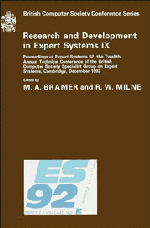Book contents
- Frontmatter
- Contents
- Preface
- Introduction
- CONSULTANT: providing advice for the machine learning toolbox
- A methods model for the integration of KBS and conventional information technology
- KBS methodology as a framework for co-operative working
- Project management for the evolutionary development of expert systems
- The specification and development of rule-based expert systems
- Towards a method for multi-agent system design
- Jigsaw: configuring knowledge acquisition tools
- On the relationship between repertory grid and term subsumption knowledge structures: theory practice tools
- Strategy maze: an on-line tool for support management of the knowledge acquisition process
- Concurrent engineering using collaborating truth maintenance systems
- Ockham's razor as a gardening tool
- A designer's consultant
- Fairness of attribute selection in probabilistic induction
- An application of case-based expert system technology to dynamic job-shop scheduling
- Neural network design via LP
- KEshell2: an intelligent learning data base system
- Approaches to self-explanation and system visibility in the context of application tasks
- An object oriented approach to distributed problem solving
- Intelligent user interface for multiple application systems
- Combining qualitative and quantitative information for temporal reasoning
- Documents as expert systems
An application of case-based expert system technology to dynamic job-shop scheduling
Published online by Cambridge University Press: 04 August 2010
- Frontmatter
- Contents
- Preface
- Introduction
- CONSULTANT: providing advice for the machine learning toolbox
- A methods model for the integration of KBS and conventional information technology
- KBS methodology as a framework for co-operative working
- Project management for the evolutionary development of expert systems
- The specification and development of rule-based expert systems
- Towards a method for multi-agent system design
- Jigsaw: configuring knowledge acquisition tools
- On the relationship between repertory grid and term subsumption knowledge structures: theory practice tools
- Strategy maze: an on-line tool for support management of the knowledge acquisition process
- Concurrent engineering using collaborating truth maintenance systems
- Ockham's razor as a gardening tool
- A designer's consultant
- Fairness of attribute selection in probabilistic induction
- An application of case-based expert system technology to dynamic job-shop scheduling
- Neural network design via LP
- KEshell2: an intelligent learning data base system
- Approaches to self-explanation and system visibility in the context of application tasks
- An object oriented approach to distributed problem solving
- Intelligent user interface for multiple application systems
- Combining qualitative and quantitative information for temporal reasoning
- Documents as expert systems
Summary
ABSTRACT
This paper describes the structure and components of a case-based scheduler named CBS-1 which is being created to demonstrate the feasibility and utility of case-based reasoning (CBR) for dynamic job-shop scheduling problems. The paper describes the characteristics of a specific real-world scheduling task used in the work on CBS-1, identifies major problems to consider, and gives arguments for and against the application of CBR. The functions of the components of the system are illustrated by examples. Finally, some existing case-based schedulers are compared with CBS-1.
INTRODUCTION
Scheduling is the allocation of resources, like machines or human power, to operations over time to achieve certain goals. In job-shop scheduling the goals to be achieved are the processing or production of discrete parts in several steps each requiring several different resources. Dynamic scheduling is scheduling simultaneously with the execution of the processes that are affected by the created schedules.
In the Interuniversitary Centre for CIM (IUCCIM) in Vienna the production process for remote controlled toy cars is used to demonstrate the main ideas in CIM. In this context the problem of scheduling incoming orders for toy cars into the ongoing production process arises. There are several reasons for the complexity of such a scheduling task.
There is a combinatorial explosion of the number of possible schedules (which must be checked for feasibility) in each problem dimension such as the number of machines and operations.
[…]
- Type
- Chapter
- Information
- Research and Development in Expert Systems IX , pp. 225 - 236Publisher: Cambridge University PressPrint publication year: 1993



